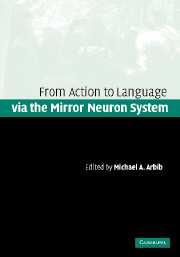Book contents
- Frontmatter
- Contents
- List of contributors
- Preface
- Part I Two perspectives
- Part II Brain, evolution, and comparative analysis
- Part III Dynamic systems in action and language
- Part IV From mirror system to syntax and Theory of Mind
- 9 Attention and the minimal subscene
- 10 Action verbs, argument structure constructions, and the mirror neuron system
- 11 Language evidence for changes in a Theory of Mind
- Part V Development of action and language
- Index
- References
11 - Language evidence for changes in a Theory of Mind
Published online by Cambridge University Press: 01 September 2009
- Frontmatter
- Contents
- List of contributors
- Preface
- Part I Two perspectives
- Part II Brain, evolution, and comparative analysis
- Part III Dynamic systems in action and language
- Part IV From mirror system to syntax and Theory of Mind
- 9 Attention and the minimal subscene
- 10 Action verbs, argument structure constructions, and the mirror neuron system
- 11 Language evidence for changes in a Theory of Mind
- Part V Development of action and language
- Index
- References
Summary
Introduction
One topic that is strikingly pervasive across the cognitive sciences is that of Theory of Mind, referring to the abilities that people have in reasoning about their own mental states and those of others. It is the set of Theory of Mind abilities that enable people to reflect introspectively on their own reasoning, to empathize with other people by imagining what it would be like to be in their position, and to generate reasonable expectations and inferences about mental states and processes.
Although there are inherent difficulties involved in investigating behavior that is largely unobservable, a relatively sophisticated understanding of Theory of Mind abilities has emerged through the synthesis of widely disparate sources of evidence. This evidence suggests that Theory of Mind abilities progressively develop in children and adults (Happé et al., 1998; Wellman and Lagattuata, 2000), are degraded in people diagnosed with the illness of autism (Baron-Cohen, 2000), have a relationship to localized brain regions (Happé et al., 1999; Frith and Frith, 2000), and are a uniquely human cognitive faculty not available to other primates, e.g. chimpanzees and orangutans (Call and Tomasello, 1999). This last contribution to our understanding of Theory of Mind suggests that these abilities must have arisen in the human lineage only after a split from that of chimpanzees some 6–8 million years ago (but see Stanford, this volume, for a review of dissenting opinions).
- Type
- Chapter
- Information
- Action to Language via the Mirror Neuron System , pp. 374 - 394Publisher: Cambridge University PressPrint publication year: 2006



